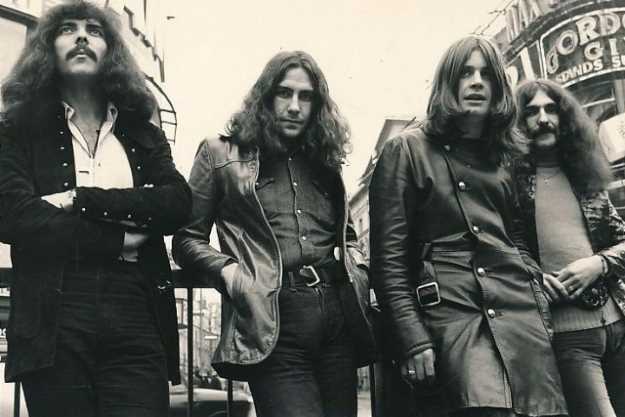|
Taken from The Michigan Daily (Oct 25, 2017)
Darkness and the Occult: A brief history of doom metal
by Selena Aguilera

NOSELL - Vertigo Records |
Inspired by gruesome death, darkness and the occult, Doom Metal has become the ultimate projection of fear in music. The legendary genre rose from the ground during 1970 in the form of Black Sabbath — the high priests of heavy metal, the creators of doom. The band gave the world an introduction to chunky basslines and sleazy guitar riffs all played in a slower tempo, drenched in haunting lyrics to create an inescapable eeriness that floods the ears.
Black Sabbath started it all after being released in the United Kingdom on the most appropriate date: Friday 13, 1970. Frontman Ozzy Osbourne’s voice floats over the slow, dense music and it replaces gravity, pushing and pulling the body in every direction with each word escaping his mouth. “Visions cupped within a flower / Deadly petals with strange powers,” Osbourne sings in “Behind the Wall of Sleep.” The song is influenced by the common practice in Wicca and other cultures of using plants to enhance the physical and mental states of a person and their environments, but its demonized to depict a resurrection of sorts.
Though Black Sabbath has occult influence, they were more inspired by the harsh mass of death that surrounded Vietnam, and they focused on intense lyrical content that included different renditions of the end of the world, war and drug addiction. In the song “Hand of Doom,” Osbourne sings, “First it was the bomb / Vietnam napalm / Disillusioning / You push the needle in,” describing the timeline from soldier to drug addict as an effect of PTSD in four short lines.
Black Sabbath’s honest representation of the hells on Earth and their pioneering instrumentals created a recipe to induce terror through sound, but doom after 1970 began honing in on the use of surrealism in their lyrical content. The brutal reality of death and horrors in history were still present in doom, but there was a new portrayal of a more monster-esque type of darkness. Doom was taking a break from the capitalist, war-hungry cesspool Earth, and stepping into the eccentric wormhole of nightmares.
Pentagram executed the new strategy effortlessly in their 1985 self-titled record that brings fear to life through a more occult lens. Some of the album is sung from the perspective of a supernatural force instead of a human observer. In “Sinister,” frontman Bobby Liebling sings, “I am the priest of Hell make a slave of you,” in which the narrator becomes Satan.
Liebling manifests as another gruesome identity in “The Ghoul,” where he sings, “I've come to desecrate your bones / As maggots crawl amongst your flesh / You're soon to meet the truth of death.” Its guitar riffs ooze desecrated sounds that pull the victim in closer to the song, while the drums replace their heartbeat and shake their lungs.
Pentagram’s ability to lace their murky instrumentals with gorey lyrics made doom more imaginative and creepy. It gave way to more varied interpretation and odd content that was cultivated in the genre during the ’90s.
During that time, Electric Wizard became the Doom Metal oddity composed of cultural fascinations from European porn to Detroit garage rock. They pulled inspiration from the dark masters before them and integrated it with other horrific material from ’60s and ’70s gore films and the terror tales of H.P. Lovecraft. Their album titles reflect some of their influences, with names like Black Masses, Time to Die, Dopethrone and Witchcult Today.
Witchcult Today sounds like the epitome of doom. It starts with the sound of crying winds and is rancid with chiller influences. The second song, “Dunwich” is a panicked and blackened interpretation of Lovecraft’s “The Dunwich Horror,” a short story about horrific events that occur in the fictional Dunwich, New England surrounded by hills and full of silence, with a past of witch-blood and Satan-Worship. Liz Buckingham’s heavy guitar riffs and Jus Oborn’s rough, scratchy voice envelope the listener into a mystic environment, into their own personal Dunwich.
Electric Wizard then moves from a surreal song inspired by a fictional world into something inspired by events in history in “Torquemada 71,” which calls attention to the Spanish friar, Tomas de Torquemada. He was responsible for the burning of 2,000 heretics and for the torture and death of many more. Oborn’s voice singing, “Come now and torture me” becomes soaked in heavy guitar fuzz and slashy distortion. It sounds torturous and drawn out, like the dismemberment of a body part.
Electric Wizard is a doom curated from the disgusting truth in bands like Black Sabbath, and their surreal counterparts like Pentagram. It melts each influence together into a sound of dripping black tar from the top of a succubus leading to the void. Other present doom bands that level with Electric Wizard are Sleep and Uncle Acid & the Deadbeats, who project doom with their own blackened style. They keep doom thriving after 47 years of existing. It remains to be one of the most prominent sub-genres of metal because of its growing sludge sound and consistent themes of death, darkness and the occult.
|